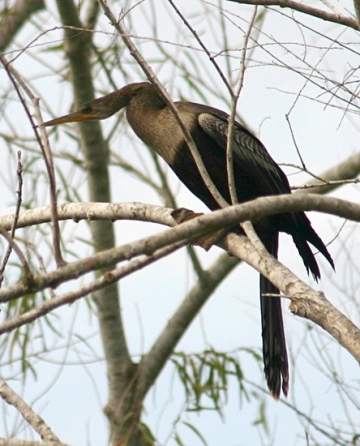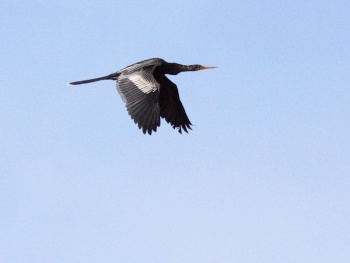m (add imperial measurements to Identification) |
m |
||
| Line 1: | Line 1: | ||
| − | '''''Anhinga''' redirects here. For the genus Anhinga, see '''[[:Category:Anhinga|Anhinga]]''''' | + | :'''''Anhinga''' redirects here. For the genus Anhinga, see '''[[:Category:Anhinga|Anhinga]]''''' |
[[Image:Anhinga.jpg|thumb|550px|right|Male: Photo by {{user|stejon|stejon}}<br />[[Florida]], [[USA]]]] | [[Image:Anhinga.jpg|thumb|550px|right|Male: Photo by {{user|stejon|stejon}}<br />[[Florida]], [[USA]]]] | ||
;[[:Category:Anhinga|Anhinga]] anhinga | ;[[:Category:Anhinga|Anhinga]] anhinga | ||
Revision as of 14:02, 15 August 2010
- Anhinga redirects here. For the genus Anhinga, see Anhinga
- Anhinga anhinga
Identification
L. 35" (89 cm); Ws. 45" (114 cm)
- Slender
- Dark body
- Long tail and neck
Male:
- Jet black with green iridescence
- Dramatic silver and white markings on upper back and forewings
- Long, sharp yellow bill
- Red eyes with blue skin
Female:
- Dark brown overall
- Lighter brown head, neck, and breast
Distribution
In the U.S., it is found all along the Gulf of Mexico coast, inland east Texas to Florida.
It is also found along a narrow strip on the southwest coast of Mexico, in Cuba (vagrant in the rest of the Caribbean), and in Central and South America from Guatemala, Belize and Trinidad and Tobago south to Argentina (but not Chile).
Taxonomy
Subspecies[1]
Two subspecies are recognized:
- A. a. leucogaster:
- South-eastern US to Panama, Cuba and Isle of Pines
- A. a. anhinga:
- Trinidad, Tobago and northern South America to northern Argentina
Habitat
Freshwater ponds, lakes, and marshes.
Behaviour
Dives frequently for fish, which it spears with its long sharp bill, then tosses them in the air until it can swallow them headfirst.
The colloquial name, Snakebird, can be quite descriptive when this bird is in the water - it swims with its body mostly submerged, and just the long sinuous neck above. On quick glance, it can thus appear to be a swimming snake. The other common posture is on a tree near or over water, where it spends hours with wings extended, drying in the sun; unlike ducks, it has no oil with which to waterproof its feathers, an adaptation to improve its diving ability.
Monogamous.
References
- Clements, JF. 2008. The Clements Checklist of Birds of the World. 6th ed., with updates to December 2008. Ithaca: Cornell Univ. Press. ISBN 978-0801445019.
Recommended Citation
- BirdForum Opus contributors. (2024) Anhinga. In: BirdForum, the forum for wild birds and birding. Retrieved 17 May 2024 from https://www.birdforum.net/opus/Anhinga
External Links
- Anhinga USGS Patuxent Wildlife Research Center
- Anhinga videos on the Internet Bird Collection
- Arthur Grosset's Birds






